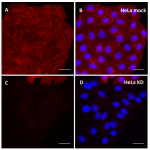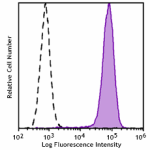- Clone
- W21139F (See other available formats)
- Regulatory Status
- RUO
- Other Names
- DBN-1, DBN 1, D0S117E; Developmentally-regulated brain protein; Drebrin 1; Drebrin; Drebrin E; Drebrin E2; DKFZp434D064
- Isotype
- Rat IgG2b, κ
- Ave. Rating
- Submit a Review
- Product Citations
- publications

-

Whole cell extracts (15 µg total protein per lane) from the indicated cell lines were resolved on a 4-12% Bis-Tris gel, transferred to a PVDF membrane, and probed with 1 µg/mL of Purified anti-DBN1 (clone W21139F) overnight at 4°C. Proteins were visualized by chemiluminescence detection using HRP Goat anti-rat IgG (Cat. No. 405405) at a 1:5000 dilution. Direct-Blot™ HRP anti-β-actin (Cat. No. 664804) was used as a loading control at a 1:25000 dilution. Western-Ready™ ECL Substrate Premium Kit (Cat. No. 426319) was used as a detection agent. Lane M: Molecular weight marker -

HeLa cells without (panels A and B) or with DBN1 knockdown (panels C and D) were fixed with ice-cold methanol, and then blocked with 5% FBS for 1 hour at room temperature. Cells were then intracellularly stained with 5 µg/mL of Purified anti-DBN1 (clone W21139F), followed by incubation with 2.5 µg/mL of Alexa Fluor® 594 Goat anti-rat IgG (Cat. No. 405422) for 1 hour at room temperature. Nuclei were counterstained with DAPI (Cat. No. 422801) (blue, panels B and D). The image was captured with a 40X objective. Scale bar: 25 µm -

Intracellular flow cytometry (ICFC) staining of purified anti-DBN1 (clone W21139F). SHSY5Y cells were fixed and permeabilized with Cyto-Fast™ Fix/Perm buffer set (Cat No. 426803), and then intracellularly stained with Purified anti-DBN1 (clone W21139F) (filled histogram) or Purified rat IgG2b, κ isotype control (Cat. No. 400601) (open histogram), followed by incubation with 0.1 µg/test of APC Goat anti-rat IgG (Cat. No. 405407) for 15 min at room temperature.
| Cat # | Size | Price | Save |
|---|---|---|---|
| 633251 | 25 µg | ¥39,600 | |
| 633252 | 100 µg | ¥97,900 |
Drebrin (DBN1) is an actin-binding protein that was identified as a developmentally regulated protein expressed in the brain. Drebrin interacts with microtubules and is localized to focal adhesions, adherens junctions, gap junctions, immunological synapses, and neuronal synapses to modulate cellular processes such as cell migration, cell process formation, cancer metastasis, and spermatogenesis. There are two isoforms of mammals as a result of alternative splicing: Drebrin A (adult) and Drebrin E (embryonic). The expression of Drebrin A is highly specific to neurons and regulates the reorganization of actin filaments and thus contributes to memory, whereas Drebrin E is expressed in various tissues. Studies have shown that a decrease in the amount of Drebrin protein in the brain is thought to be a factor contributing to the pathogenesis of dementia in Alzheimer's disease (AD), Down syndrome (DS), and bipolar disorder (BD).
Product DetailsProduct Details
- Verified Reactivity
- Human
- Antibody Type
- Monoclonal
- Host Species
- Rat
- Immunogen
- Partial recombinant human DBN1 protein
- Formulation
- Phosphate-buffered solution, pH 7.2, containing 0.09% sodium azide
- Preparation
- The antibody was purified by affinity chromatography.
- Concentration
- 0.5 mg/mL
- Storage & Handling
- The antibody solution should be stored undiluted between 2°C and 8°C.
- Application
-
WB - Quality tested
ICC, ICFC - Verified - Recommended Usage
-
Each lot of this antibody is quality control tested by western blotting. For western blotting, the suggested use of this reagent is 0.125 - 1.0 µg/mL. For immunocytochemistry, a concentration range of 1.0 - 5.0 μg/mL is recommended. For flow cytometric staining, the suggested use of this reagent is ≤ 0.06 µg per million cells in 100 µL volume. It is recommended that the reagent be titrated for optimal performance for each application.
- Application Notes
-
The clone does not cross-react with mouse in western blotting (WB).
For immunocytochemistry (ICC), we recommend to use 4% PFA fixation followed by permeabilization with 0.5% Triton X-100 or ice cold-methanol, or ice-cold methanol fixation.
For intracellular flow cytometry (ICFC), the recommended dosage is 0.06 μg per test using Fixation Buffer (Cat. No. 420801) followed by True-Phos™ Perm Buffer (Cat No. 425401), or Intracellular Staining Permeabilization Wash Buffer (Cat No. 421002), or using Cyto-Fast™ Fix/Perm Buffer Set (Cat. No. 426803) and True-Nuclear™ Transcription Factor Buffer Set (Cat. No. 424401).
This product is not recommended for use in immunohistochemistry (IHC). - Additional Product Notes
-
This antibody has been tested in knockout/knockdown models for ICC.
- RRID
-
AB_3097581 (BioLegend Cat. No. 633251)
AB_3097581 (BioLegend Cat. No. 633252)
Antigen Details
- Structure
- DBN1 protein is a 649 amino acid protein with a predicted molecular weight of 71 kD.
- Distribution
-
Expressed in the brain, the heart, lymphocytes, placenta, lung, skeletal muscle, kidney, pancreas, skin fibroblasts, gingival fibroblasts, and bone-derived cells
- Function
- Cytoplasmic actin-binding protein, regulate dendritic spine morphogenesis and organization
- Interaction
- RUFY3, CXCR4, ZMYND8
- Cell Type
- Endothelial cells, Lymphocytes, Monocytes, Platelets
- Biology Area
- Immunology
- Molecular Family
- Adhesion Molecules, CD Molecules
- Antigen References
-
- Kojima N, et al. 1993. Brain Res Mol Brain Res. 19:101-14.
- Ishikawa R, et al.1994. J Biol Chem.269:29928-33.
- Butkevich E, et al.2004. Curr Biol. 14:650-8.
- Shirao T, et al. 2017. J Neurochem. 141:819-834.
- Peitsch WK, et al. 1999. Eur J Cell Biol. 78:767-78.
- Li MW, et al. 2011. Spermatogenesis. 1:123-136.
- Geraldo S, et al. 2008. Nat Cell Biol. 10:1181-9.
- Grintsevich EE, et al. 2017. Adv Exp Med Biol. 1006:61-82.
- Stiber J.A, et al. 2016. Arterioscler Thromb Vasc Biol.36:984-93.
- Shim K.S, et al. 2002. Neurosci Lett. 324:209-12.
- Kim H.W, et al. 2010. Neurobiol Dis. 37:596-603.
- Gene ID
- 1627 View all products for this Gene ID
- UniProt
- View information about DBN1 on UniProt.org
Other Formats
View All DBN1 Reagents Request Custom Conjugation| Description | Clone | Applications |
|---|---|---|
| Purified anti-DBN1 | W21139F | WB,ICC,ICFC |
Compare Data Across All Formats
This data display is provided for general comparisons between formats.
Your actual data may vary due to variations in samples, target cells, instruments and their settings, staining conditions, and other factors.
If you need assistance with selecting the best format contact our expert technical support team.










Follow Us